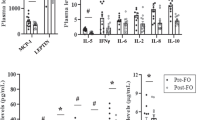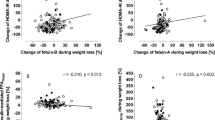Abstract
Objective:
Proteins involved in cellular fatty acid (FA) uptake and metabolism may be of relevance in the context of disturbed FA metabolism associated with insulin resistance. Therefore this study investigated relationships between FA handling protein mRNA expression in adipose tissue, FA composition of adipose tissue and serum, and markers of insulin resistance.
Subjects:
75 subjects with a range of insulin sensitivities recruited from a cohort of 294 healthy 63-year-old Swedish men.
Measurements:
Anthropometric and biochemical variables (e.g. waist-hip-ratio (WHR) and homeostasis model assessment (HOMA) index of insulin sensitivity), FA composition of the subcutaneous (s.c.) gluteal adipose tissue, serum nonesterified FA (NEFA) and serum phospholipid compartments (by gas–liquid chromatography; n=294), and mRNA levels of FA handling proteins (adipocyte and keratinocyte lipid binding proteins, fatty acid transport protein (FATP) −1 and −4, CD36/fatty acid translocase, plasma membrane fatty acid binding protein, and acyl-CoA synthase-1 (ACS1)) in s.c. gluteal adipose tissue (by quantitative real-time polymerase chain reaction; n=75).
Results:
ACS1 expression was negatively correlated with measures of insulin resistance and central obesity (ACS1 versus HOMA: r=−0.28, P<0.05; ACS1 versus WHR: r=−0.23, P<0.05), with an opposite trend for FATP4. Further analysis of ACS1 expression levels revealed correlations with adipose tissue 16:0 (r=−0.27, P<0.05) and NEFA 16:1 (r=0.29, P<0.05), FA composition variables which in turn correlated with HOMA index (r=0.39, P<0.001 and r=−0.23, P<0.05, respectively, n=75). Moreover, NEFA 16:1 predicted ACS1 expression independently of HOMA, WHR and adipose tissue 16:0 in multiple regression analysis (standardized coefficient=0.27, P<0.05).
Conclusion:
Significant associations were found between measures of insulin sensitivity, adipose tissue FA handling protein expression, and specific FA composition variables. Although causal relationships could not be identified these findings suggest a role of FA handling proteins in relation to insulin sensitivity, via their involvement in FA trafficking and metabolism. In particular they indicate links between ACS1 activity, the distribution of 16:0 and 16:1, and insulin sensitivity, which may be of physiological relevance.
This is a preview of subscription content, access via your institution
Access options
Subscribe to this journal
Receive 12 print issues and online access
$259.00 per year
only $21.58 per issue
Buy this article
- Purchase on Springer Link
- Instant access to full article PDF
Prices may be subject to local taxes which are calculated during checkout

Similar content being viewed by others
Abbreviations
- ACS1:
-
acyl-CoA synthase-1
- ALBP:
-
adipocyte lipid binding protein
- BMI:
-
body mass index
- CE:
-
cholesteryl ester
- CoA:
-
coenzyme-A
- FABP:
-
fatty acid binding protein
- FATP:
-
fatty acid transport protein
- HDL:
-
high-density lipoprotein
- HOMA:
-
homeostasis model assessment
- KLBP:
-
keratinocyte lipid binding protein
- LDL:
-
low-density lipoprotein
- NEFA:
-
nonesterified fatty acid
- PL:
-
phospholipid
- SAD:
-
sagittal abdominal diameter
- SFA:
-
saturated fatty acid
- TG:
-
triglyceride
- VLDL:
-
very low-density lipoprotein
- WHR:
-
waist-hip-ratio
References
Abumrad NA, El-Maghrabi MR, Amri EZ, Lopez E, Grimaldi PA (1993). Cloning of a rat adipocyte membrane protein implicated in binding or transport of long-chain fatty acids that is induced during preadipocyte differentiation. Homology with human CD36. J Biol Chem 268, 17665–17668.
Binnert C, Koistinen HA, Martin G, Andreelli F, Ebeling P, Koivisto VA et al. (2000). Fatty acid transport protein-1 mRNA expression in skeletal muscle and in adipose tissue in humans. Am J Physiol Endocrinol Metab 279, E1072–E1079.
Boberg M, Croon LB, Gustafsson IB, Vessby B (1985). Platelet fatty acid composition in relation to fatty acid composition in plasma and to serum lipoprotein lipids in healthy subjects with special reference to the linoleic acid pathway. Clin Sci (London) 68, 581–587.
Borkman M, Storlien LH, Pan DA, Jenkins AB, Chisholm DJ, Campbell LV (1993). The relation between insulin sensitivity and the fatty-acid composition of skeletal-muscle phospholipids. New Engl J Med 328, 238–244.
Carlson K (1973). Lipoprotein fractionation. J Clin Path Suppl 5, 32–37.
Coe NR, Bernlohr DA (1998). Physiological properties and functions of intracellular fatty acid-binding proteins. Biochim Biophys Acta 1391, 287–306.
Coe NR, Smith AJ, Frohnert BI, Watkins PA, Bernlohr DA (1999). The fatty acid transport protein (FATP1) is a very long chain acyl-CoA synthetase. J Biol Chem 274, 36300–36304.
Coleman RA, Lewin TM, Van Horn CG, Gonzalez-Baró MR (2002). Do long-chain acyl-CoA synthases regulate fatty acid entry into synthetic versus degradative pathways? J Nutr 132, 2123–2126.
Fisher RM, Gertow K (2005). Fatty acid transport proteins and insulin resistance. Curr Opin Lipidol 16, 173–178.
Fisher RM, Hoffstedt J, Hotamisligil GS, Thörne A, Rydén M (2002). Effects of obesity and weight loss on the expression of proteins involved in fatty acid metabolism in human adipose tissue. Int J Obes Relat Metab Disord 26, 1379–1385.
Frayn KN (2002). Adipose tissue as a buffer for daily lipid flux. Diabetologia 45, 1201–1210.
Gertow K, Pietiläinen K, Yki-Järvinen H, Kaprio J, Rissanen A, Eriksson P et al. (2004). Expression of fatty-acid-handling proteins in human adipose tissue in relation to obesity and insulin resistance. Diabetologia 47, 1118–1125.
Grundy SM, Cleeman JI, Daniels SR, Donato KA, Eckel RH, Franklin BA et al. (2005). Diagnosis and management of the metabolic syndrome. An American Heart Association/National Heart, Lung, and Blood Institute scientific statement. Circulation 112, 2735–2752.
Hall AM, Wiczer BM, Herrmann T, Stremmel W, Bernlohr DA (2005). Enzymatic properties of purified murine fatty acid transport protein 4 and analysis of acyl CoA synthetase activities in tissues from FATP4 null mice. J Biol Chem 280, 11948–11954.
Halliwell KJ, Fielding BA, Samra JS, Humphreys SM, Frayn KN (1996). Release of individual fatty acids from human adipose tissue in vivo after an overnight fast. J Lipid Res 37, 1842–1848.
Herrmann T, Buchkremer F, Gosch I, Hall AM, Bernlohr DA, Stremmel W (2001). Mouse fatty acid transport protein 4 (FATP4): characterization of the gene and functional assessment as a very long chain acyl-CoA synthetase. Gene 270, 31–40.
Herrmann T, van der Hoeven F, Gröne H-J, Stewart AF, Langbein L, Kaiser I et al. (2003). Mice with targeted disruption of the fatty acid transport protein 4 (Fatp4, Slc27a4) gene show features of lethal restrictive dermopathy. J Cell Biol 161, 1105–1115.
Hirsch D, Stahl A, Lodish HF (1998). A family of fatty acid transporters conserved from mycobacterium to man. Proc Natl Acad Sci USA 95, 8625–8629.
Isola LM, Zhou S-L, Kiang C-L, Stump DD, Bradbury MW, Berk PD (1995). 3T3 fibroblasts transfected with a cDNA for mitochondrial aspartate aminotransferase express plasma membrane fatty acid-binding protein and saturable fatty acid uptake. Proc Natl Acad Sci USA 92, 9866–9870.
Kannisto K, Sutinen J, Korsheninnikova E, Fisher RM, Ehrenborg E, Gertow K et al. (2002). Expression of adipogenic transcription factors, peroxisome proliferator-activated receptor gamma co-activator 1, IL-6 and CD45 in subcutaneous adipose tissue in lipodystrophy associated with highly active antiretroviral therapy. AIDS 17, 1753–1762.
Katan MB, Deslypere JP, van Birgelen AP, Penders M, Zegwaard M (1997). Kinetics of the incorporation of dietary fatty acids into serum cholesteryl esters, erythrocyte membranes, and adipose tissue: an 18-month controlled study. J Lipid Res 38, 2012–2022.
Lovejoy JC, Champagne CM, Smith SR, DeLany JP, Bray GA, Lefevre M et al. (2001). Relationship of dietary fat and serum cholesterol ester and phospholipid fatty acids to markers of insulin resistance in men and women with a range of glucose tolerance. Metabolism 50, 86–92.
Pan DA, Lillioja S, Milner MR, Kriketos AD, Baur LA, Bogardus C et al. (1995). Skeletal muscle membrane lipid composition is related to adiposity and insulin action. J Clin Invest 96, 2802–2808.
Pelikanova T, Kazdova L, Chvojkova S, Base J (2001). Serum phospholipid fatty acid composition and insulin action in type 2 diabetic patients. Metabolism 50, 1472–1478.
Rosell M, de Faire U, Hellénius M-L (2003). Low prevalence of the metabolic syndrome in wine drinkers – is it the alcohol beverage or the lifestyle? Eur J Clin Nutr 57, 227–234.
Rosell MS, Héllenius M-LB, de Faire UH, Johansson GK (2003). Associations between diet and the metabolic syndrome vary with the validity of dietary intake data. Am J Clin Nutr 78, 84–90.
Salomaa V, Ahola I, Tuomilehto J, Aro A, Pietinen P, Korhonen HJ et al. (1990). Fatty acid composition of serum cholesterol esters in different degrees of glucose intolerance: a population-based study. Metabolism 39, 1285–1291.
Schaffer JE, Lodish HF (1994). Expression cloning and characterization of a novel adipocyte long chain fatty acid transport protein. Cell 79, 427–436.
Sleeman MW, Donegan NP, Heller-Harrison R, Lane WS, Czech MP (1998). Association of actyl-CoA synthetase-1 with GLUT4-containing vesicles. J Biol Chem 273, 3132–3135.
Stahl A, Gimeno RE, Tartaglia LA, Lodish HF (2001). Fatty acid transport proteins: a current view of a growing family. Trends Endocrinol Metab 12, 266–273.
Stremmel W, Strohmeyer G, Borchard F, Kochwa S, Berk PD (1985). Isolation and partial characterization of a fatty acid binding protein in rat liver plasma membranes. Proc Natl Acad Sci USA 82, 4–8.
Stahl A, Evans JG, Pattel S, Hirsch D, Lodish HF (2002). Insulin causes fatty acid transport protein translocation and enhanced fatty acid uptake in adipocytes. Dev Cell 2, 477–488.
Vessby B (2003). Dietary fat, fatty acid composition in plasma and the metabolic syndrome. Curr Opin Lipidol 14, 15–19.
Vessby B, Gustafsson I-B, Tengblad S, Boberg M, Andersson A (2002). Desaturation and elongation of fatty acids and insulin action. Ann NY Acad Sci 967, 183–195.
Vessby B, Tengblad S, Lithell H (1994). Insulin sensitivity is related to the fatty acid composition of serum lipids and skeletal muscle phospholipids in 70-year-old men. Diabetologia 37, 1044–1050.
Acknowledgements
This work was supported by the Swedish Medical Research Council (project 15352), the Torsten and Ragnar Söderberg Foundation, the Swedish Heart-Lung Foundation, the Swedish Institute, the Swedish National Network and Graduate School for Cardiovascular Research, the Professor Nanna Svartz Foundation, the Åke Wiberg Foundation, the Nilsson-Ehle Foundation, the Fredrik and Ingrid Thuring Foundation, the Gamla Tjänarinnor Foundation, the Swedish Society of Medicine, the Swedish Dairy Association, the Stockholm County Council, and the Swedish Council for Working Life and Social Research.
Author information
Authors and Affiliations
Corresponding author
Additional information
Guarantors: K Gertow and RM Fisher.
Contributors: MR, PS, PE, BV, UdF, AH, M-LH.
Rights and permissions
About this article
Cite this article
Gertow, K., Rosell, M., Sjögren, P. et al. Fatty acid handling protein expression in adipose tissue, fatty acid composition of adipose tissue and serum, and markers of insulin resistance. Eur J Clin Nutr 60, 1406–1413 (2006). https://doi.org/10.1038/sj.ejcn.1602471
Received:
Revised:
Accepted:
Published:
Issue Date:
DOI: https://doi.org/10.1038/sj.ejcn.1602471
Keywords
This article is cited by
-
Association between carbohydrate intake and fatty acids in the de novo lipogenic pathway in serum phospholipids and adipose tissue in a population of Swedish men
European Journal of Nutrition (2020)
-
Genome-wide association study identifies novel genetic variants contributing to variation in blood metabolite levels
Nature Communications (2015)
-
The Alpha Linolenic Acid Content of Flaxseed is Associated with an Induction of Adipose Leptin Expression
Lipids (2011)
-
Serum saturated fatty acids containing triacylglycerols are better markers of insulin resistance than total serum triacylglycerol concentrations
Diabetologia (2009)
-
Fatty acid desaturases in human adipose tissue: relationships between gene expression, desaturation indexes and insulin resistance
Diabetologia (2008)



